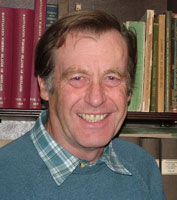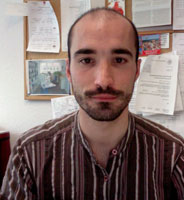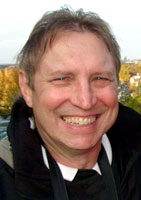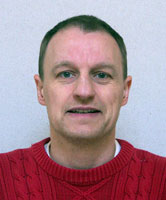 Carolin Haug
Carolin Haug
Department of Geology and Geophysics
Yale University
Kline Geology Laboratory
210 Whitney Avenue
New Haven, Connecticut 06511
USA
Current address: Zoological Institute and Museum, Cytology and Evolutionary Biology, University of Greifswald, Soldmannstr. 23, 17487 Greifswald, Germany
Carolin Haug studied biology at the Julius-Maximilians-Universität Würzburg with animal ecology as major subject and sociobiology and palaeontology as minor subjects. She received her Diplom in 2005 and moved to the University of Ulm for her PhD thesis. In the work group Biosystematic Documentation she investigated the ontogeny and evolution of the arthropod head shield on a wide spectrum of fossil and extant specimens. Due to the very different demands of the material, she developed new imaging techniques or modified existing methods together with her collaborators, for example, composite imaging, stereo photography or autofluorescence macro- and microscopy. In 2011, Carolin defended her PhD thesis. She is currently as postdoctoral researcher at Yale University. Besides optimising imaging techniques, she is interested in fossilised development (see also http://www.palaeo-evo-devo.info) and in the evolution of tagmosis. For this purpose, she investigates mainly arthropods from different deposits yielding exceptional preservation, such as Rhynie chert, Solnhofen Lithographic Limestones, the 'Orsten', Burgess Shale, or Mazon Creek, always in comparison to their extant relatives. Carolin will move to Greifswald in June 2012 to continue her research there at the Ernst-Moritz-Arndt-Universität.
![]()
Joachim T. Haug Department of Geology and Geophysics
Department of Geology and Geophysics
Yale University
Kline Geology Laboratory
210 Whitney Avenue
New Haven, Connecticut 06511
USA
Current address: Zoological Institute and Museum, Cytology and Evolutionary Biology, University of Greifswald, Soldmannstr. 23, 17487 Greifswald, Germany
Joachim T. Haug studied animal ecology (major), sociobiology and palaeontology (minors) at the Julius-Maximilians-Universität Würzburg. After the receipt of the Diplom in 2005, he moved to the work group Biosystematic Documentation at the University of Ulm for his PhD thesis. There he worked on the early crustaceans from the Cambrian 'Orsten', which are preserved three-dimensionally and with minute details. To make the entire morphology clearly visible, Joachim produced computer-based 3D models for each developmental stage of a species, resulting in a 4D model of the species. With 4D models reconstructed for the different species, differences in the developmental pattern between the species became visible. These changes in the developmental timing, so-called heterochronic events must have occurred several times during early crustacean evolution. Due to these findings, Joachim got interested in studying such evolutionary changes of development also in fossils from other deposits and focussed on Palaeo-Evo-Devo (see also http://www.palaeo-evo-devo.info). After his defense in 2009 and two further years as postdoctoral researcher in Ulm, he received a Feodor Lynen research fellowship from the Alexander von Humboldt-Foundation, with which he is currently doing research at Yale University. Besides 3D modelling, Joachim is also interested in different methods of imaging (documentation and presentation). In June 2012, he will relocate to the Ernst-Moritz-Arndt-Universität Greifswald.
![]()
Stephen R. Fayers Department of Geology and Petroleum Geology
Department of Geology and Petroleum Geology
School of Geosciences
University of Aberdeen
Meston Building
Kings College
Aberdeen, AB24 3UE
UK
Stephen Fayers studied geology as an undergraduate in Portsmouth and went on to complete a master’s degree, gaining a distinction in Sedimentology and its Applications at the University of Reading. Following a move to Aberdeen in Scotland to work as a sedimentologist in the oil and gas industry, Stephen returned to academia in 1999 to study the sedimentology, biota and palaeoenvironments of the Windyfield chert; part of a complex of Early Devonian (Pragian-age) terrestrial hot spring deposits found at Rhynie in NE Scotland. Finishing his Ph.D. in 2003, Stephen continued his work, in collaboration with numerous international universities, with the Rhynie Research Group at the University of Aberdeen as a Post-Doctorate Research Fellow. Since this time he has written and co-authored numerous research papers in peer-reviewed journals. Stephen currently works as a Senior Geoscientist for Baker Hughes in Aberdeen, specialising in borehole image log analysis; he also teaches borehole image log processing and interpretation at M.Sc. level for the University of Aberdeen. His primary research interests continue to centre around the palaeoenvironments, biota and palaeoecology of early terrestrial and freshwater ecosystems.
![]()
Nigel H. Trewin Department of Geology and Petroleum Geology
Department of Geology and Petroleum Geology
School of Geosciences
University of Aberdeen
Meston Building
Kings College
Aberdeen, AB24 3UE
UK
Nigel H. Trewin is an Emeritus Professor of Geology at Aberdeen University, Scotland, and Honorary Curator of the Geological Collections at the university. His academic papers over 44 years are mostly on sedimentology, diagenesis, palaeontology, stratigraphy and regional geology. Current specialisations are the Old Red Sandstone of Scotland, particularly the Rhynie chert, and fish-bed faunas. Published books include ‘The Geology of Scotland’ (Ed. 4th Edn 2002), an excursion guide book to East Sutherland and Caithness (2009) and ‘Fossils Alive’ (2008).
![]()
Christopher Castellani Biosystematic Documentation
Biosystematic Documentation
University of Ulm
Helmholtzstrasse 20
D-89081 Ulm
Germany
Christopher Castellani is currently a PhD student in the workgroup of Prof. Dr. Dieter Waloszek at the University of Ulm (Germany). He studied geology and paleontology at Brest, Marseille and Dijon (France), for five years. During his Master thesis, he specialized in modern morphometric and statistical techniques and used them to characterise the morphological disparity within the taxon Carabus. In 2007, he moved to the University of Ulm (Germany) to integrate the workgroup of Prof. Dr. Dieter Waloszek as Research Assistant. He was involved in a European Program, funded by the Marie Curie Early Stage Research Training, about the “Evolution of animal body plans as inferred by developmental biology, morphology, molecular phylogeny, and palaeontology” (project MOLMORPH). During this 1-year fellowship he worked on the ontogeny and life habit of the Upper Cambrian parasitic tongue worms Pentastomida found in various ’Orsten’ deposits of Sweden. Christopher has then started his PhD thesis in 2009 and he attempts to precise the palaeo-biodiversity and palaeo-ecology of the Cambrian ’Orsten’ assemblages of the Alum Shale Formation of Sweden. Previous investigations, under the direction of Prof. Dr. Klaus J. Müller and Prof. Dr. Dieter Waloszek, of the so-called ‘Orsten’-type fossils yielded a great number of immature and adult forms of mainly meiofaunic arthropods. However, the ‘Orsten’ faunas do not only comprise arthropod organisms, re-investigation of the original residues has led to the discoveries of numerous micropaleontolgical remains (mainly fragments) of various affinities (sponges, echinoderms, Small Shelly Fossils, brachiopods, graptolites, cyanobacteria, various ‘worms’ and unknown arthropods, and other problematic fossils). Christopher aims to draw a more realistic picture of the biodiversity of the ‘Orsten’ assemblages and more particularly of the biotas that inhabited the shallow Alum Shale sea during the Furongian (Upper Cambrian). His research techniques comprise mainly scanning electron microscopy due to the small size of the fossils, but also thin sections and modern imaging techniques such as synchrotron and fluorescence microscopy. Christopher is interested in various aspects of the ‘Orsten’-type Lagerstätten (biodiversity and taphonomic processes leading their preservation in Sweden and worldwide) and in general, in the biodiversity, in term of species richness, morphological disparity and ecological strategy, of early Palaeozoic ecosystems and their evolution through time.
![]()
Dieter Waloszek Biosystematic Documentation
Biosystematic Documentation
University of Ulm
Helmholtzstrasse 20
D-89081 Ulm
Germany
Dieter Waloszek is working as a professor at the University of Ulm. He studied biology in Hamburg and finished his dissertation with a thesis on a scallop from Argentinian offshore waters. In 1982 Dieter moved to the Institute of Palaeontology in Bonn to work together with Klaus J. Müller, the discoverer of the Cambrian 3d-preserved, so-called ‘Orsten’ fossils, mainly arthropods. After his habilitation in 1991 on one of the faunal elements, the crustacean Rehbachiella kinnekullensis, and the phylogeny of Branchiopoda and Crustacea and one year in Kiel, Dieter received a professorship in Ulm in 1995. Since then, he and his workgroup continue the studies of ‘Orsten’ fossils. Major method remains the SEM, but the workgroup expanded their investigations to other localities worldwide, material from extant and other fossil sources and their methodological range for improving the documentation of this important evolutionary data source.
More recent highlight: foundation of the international C.O.R.E. group of scientists with a specific interest in ‘Orsten’ studies.
Main interests: morphology, incl. functional aspects, ontogeny, phylogeny and evolution – no taxonomic restriction in general, but due to capacity problems, focus on Arthropoda.
Output (incl. team work): more than 100 papers in international journals.
Main hobbies: family, fistball, holidays in Sweden, incl. fishing and waterskiing.
![]()
Andreas Maas Biosystematic Documentation
Biosystematic Documentation
University of Ulm
Helmholtzstrasse 20
D-89081 Ulm
Germany
Andreas Maas is a research assistant at the University of Ulm. He studied biology at the Christian Albrechts University of Kiel, Germany and graduated in 1998 with a diploma thesis on the larval development of the Antarctic krill Euphausia superba. In 2002 he made his PhD in zoology at the University of Ulm. Andreas studied a Cambrian group of crustaceans, the Phosphatocopina; their systematic position within Crustacea could be established as the sister group of the crustacean crown group, the Eucrustacea. The material of his study is part of the so-called ‘Orsten’ type of preservation that leads to three-dimensional fossils of mainly less than 1 mm in size. Since 2002 Andreas is also involved in teaching at the University of Ulm and did his habilitation in 2008. He was part of a German-Chinese research cooperation and was able to work on fossils from the famous lower Cambrian Chengjiang fauna. With this Andreas consolidated his main research subject in the early evolution and phylogeny of arthropods. He could widen this subject also on the question of the phylogenetic position of arthropods within the Bilateria. Andreas worked on very early, worm-like arthropods without sclerotised dorsal tergites that were from the same Cambrian material as the phosphatocopines before. Another important Cambrian fossil he described was a minute, Cambrian, possibly immature stage of a new species of Cycloneuralia. Shergoldana australiensis gives some clues about the evolution of larval forms within Nemathelminthes. This is especially important since arthropods are regarded as close relatives of round worms nowadays. Andreas’ research techniques comprise mainly scanning electron microscopy due to the small size of the fossils. Important other skills are computer-aided imagery and computer-aided phylogeny analyses. Andreas teaches evolutionary biology including history and background of Darwin’s important work and evolution, systematics and phylogeny of animals, Metazoa.
![]()

